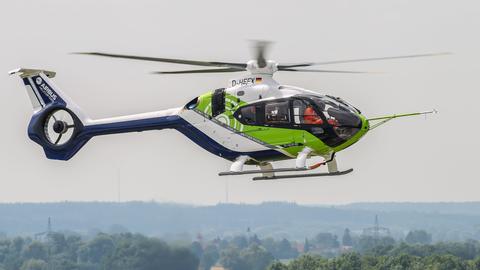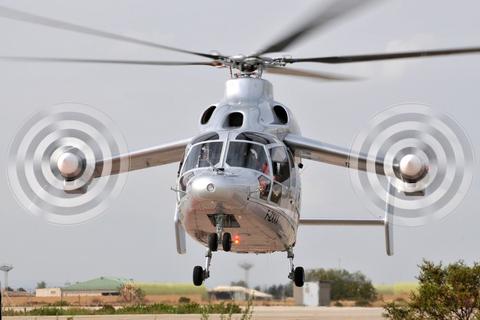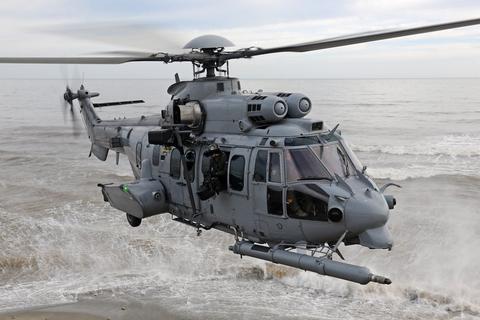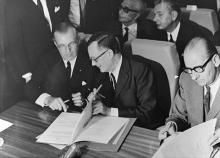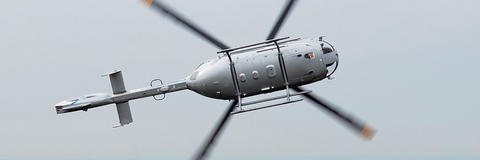2012
1 January: Eurocopter celebrates 20 years.
16 January: Eurocopter recognises the German Federal Police for reaching the 100,000 total flight hour mark with its EC135 fleet, which performs thousands of operations annually across Germany for law enforcement, home security and helicopter emergency medical services missions.
12 February: Eurocopter unveils its new EC130 T2 with optimised performance, comfort and mission diversity. Seven launch customers order 105 helicopters. New and updated features on the helicopter include the use of a more powerful Arriel 2D turboshaft engine and upgraded main gearbox; the incorporation of an active vibration control system; improved air ventilation, distribution and demisting systems; a cabin interior structure redesign with a full flat floor; a cockpit update for an enhanced man-machine interface; new energy-absorbing seats that improve weight and balance for passenger loading; integration of a crashworthy fuel tank; and increased maintenance accessibility for electrical and air conditioning systems.
1 March: EADS North America delivers the 200th UH-72A Lakota light utility helicopter to the US Army. The 200th Lakota helicopter is the first production aircraft to be delivered with the new Security and Support (S&S) Battalion Mission Equipment Package (MEP). Lakotas are produced at the company’s American Eurocopter facility in Columbus, Mississippi, which is the same facility where the initial S&S Battalion Lakotas were retrofitted. The UH-72A is a Defense Acquisition Category (ACAT) I major defence acquisition programme for the US defence department, and it marked one of the most rapid introductions of a new aircraft in the US Army’s history. Deliveries of the aircraft to National Guard units allow aging OH-58 and UH-1 rotary-wing aircraft to be retired, while UH-72As assigned to the active component of the US Army replace UH-60 Black Hawks.
17 April: Eurocopter targets the next phase of growth in Japan through business consolidation and relocation to an expanded facility at Kobe Airport. The opening of the brand-new facility is significant on two fronts – it marks the 50-year relationship that Eurocopter has with Japan when the Alouette II first plied the skies of Japan, and the industrial cooperation fostered through the years; and secondly, an official merger of two business entities to form the new Eurocopter Japan.
3 May: Eurocopter’s X3 development team wins the Howard Hughes Award for Outstanding Improvement in Helicopter Technology. Presented at AHS’ 68th Annual Forum in Fort Worth, Texas, the society’s prestigious Howard Hughes award acknowledges Eurocopter’s successful validation of its helicopter hybrid concept, which uses two turboshaft engines to power a main rotor along with two propellers installed on the tip of short-span fixed wings. The result is an advanced, cost-effective, vertical takeoff and landing transportation system offering the speed of a turboprop-powered aircraft and the full flight capabilities of a helicopter.
23 May: Eurocopter delivers the first Airbus A350 XWB jetliner passenger door, highlighting its innovative capabilities in composite technology. As prime contractor and system supplier, Eurocopter will provide a full set of door systems that will equip this latest wide body member of Airbus’ jetliner family.
20 June: Eurocopter begins the US tour of its X3 high-speed hybrid helicopter, which will demonstrate the unique operational capabilities of this advanced transportation system during a month of visits to military facilities and hub locations for civil helicopter operators. The tour was initiated with a debut X3 flight presentation at the Grand Prairie, Texas headquarters of Eurocopter’s US subsidiary – American Eurocopter – which was attended by employees, elected officials, customers and industry partners.
12 September: Eurocopter hands over the first upgraded CH-53GA transport helicopter to Germany's armed forces. The CH-53GA is equipped with state-of-the-art avionics and communications systems, which also are approved for use alongside the Tiger support helicopter and NH90 transport helicopter. Additionally, pilots will now be able to make use of a 4-axis autopilot with auto-hover automatic flight control system, as well as an up-to-date electronic warfare system for threat recognition and electronic self-protection. In another enhancement, navigational accuracy is brought up to international instrument flight rules (IFR) standards, with the upgrade extending to display and control functions – which are now contained in a glass cockpit with five multi-function displays.
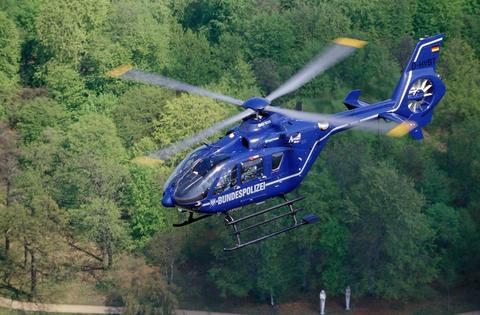
100,000 flight hours with German Federal Police.
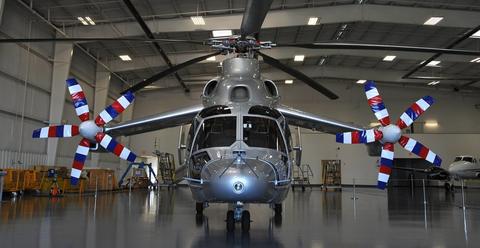
12 September: Four Tigers are delivered for deployment to Afghanistan. The Afghanistan Stabilization German Army Rapid Deployment (ASGARD) programme of modifications for the Tiger Support Helicopter was agreed upon by Eurocopter and the Federal Ministry of Defence at the end of 2011 and includes a sand filter, additional defence weaponry, a mission data recorder and enhanced communications equipment for multi-national missions.
12 September: Eurocopter hands over its first Puma MK2 aircraft to the UK Ministry of Defence. Enhancements for the Puma MK2 include major performance and safety improvements with the use of new Makila 1A1 turboshaft engines; the integration of a full glass cockpit incorporating modern avionics and a flight management system; the implementation of a digital automatic flight control system; as well as the incorporation of a secure communications suite, new defensive aids and ballistic protection for crew and passengers. Additionally, the helicopter’s greater onboard fuel capacity and lower fuel consumption will increase the Puma MK2’s operating range. The Puma will be able to carry twice the payload over three times the range than its predecessor even in the most demanding environmental conditions.
12 September: Eurocopter signs up for leadership in a European compound rotorcraft demonstration project through the Clean Sky 2 initiative. This activity will be conducted in the framework of Europe’s Clean Sky 2 Joint Technology Initiative (JTI), an extension of the Clean Sky JTI involving the European Commission and the European aviation industry, whose goal is to bring significant step changes in aviation’s environmental impact. In working towards the targets of Europe’s “Flightpath 2050” vision; the ACARE Strategic Research and Innovation Agenda; and broader societal challenges like citizen mobility, the industry and the European Union pledge jointly to invest a total of €3.6 billion over seven years on transport research in the framework of Clean Sky 2.
8 November: Starlite Aviation Group becomes the launch customer of Eurocopter's new Super Puma AS332 C1e. The AS332 C1e is a new version of Eurocopter’s Super Puma helicopter that includes a specific configuration offering shorter lead times and highly competitive operational and maintenance costs.
5 December: Eurocopter conducts the first flight of its first series-production EC175.
21 December: Eurocopter achieves a new milestone in its NH90 programme: in two ceremonies, the manufacturer delivers Belgium’s first NH90 tactical transport helicopter (TTH), along with the French DGA defense procurement agency’s first NH90 NATO frigate helicopter (NFH), in its naval Step B version, to be used by the French Navy.
2013
23 January: The first NH90 to be assembled by Eurocopter España at its facility in Albacete takes flight. This is the first military helicopter to be manufactured in Spain. This helicopter will be delivered to the Spanish Army, which will receive 37 NH90s by 2019, with 35 being manufactured in Spain.
14 February: Inauguration of a new manufacturing centre of excellence at Querétaro (Mexico), which is to produce high-technology structural metallic components for aircraft. This 12,000-square-metre facility will be the single-source production site for structures used in jetliner doors that the company manufactures for Airbus, along with tail booms to equip Ecureuil helicopters. The site is also home to a recently-opened maintenance centre specialised in the Ecureuil family.
5 March: Eurocopter launches the EC135 T3/P3. These latest variants of the EC135 include significantly improved high and hot performance, an increased maximum takeoff weight, improved flight envelope, extended range, cockpit innovations and enhanced interior versatility. The T3/P3 designations signify availability of two upgraded engine options on the helicopters: Turbomeca’s Arrius 2B2 “Plus” for the EC135 T3; and Pratt & Whitney Canada’s PWC 206B3 for the EC135 P3.
12 March: The EADS Board of Directors appoints Guillaume Faury to succeed Lutz Bertling as CEO of Eurocopter. Effective 1 May 2013, Faury joins Eurocopter from Peugeot S.A., where he served as Executive Vice President for Research & Development since 2010 and as Member of the Managing Board since 2009.
18 April: The Eurocopter Corporate Foundation takes flight. The new philanthropic organisation will support humanitarian causes.
19 April: The first production Tiger helicopter in the HAD attack configuration is delivered to France’s DGA armament procurement agency for operation by French Army Aviation units. Featured improvements of the Tiger HAD variant include two enhanced MTR390 turboshaft engines that provide 14% more power, improved ballistic protection, a new optronic sighting system, the capability to target and launch Hellfire air-to-surface missiles, an evolved electronic warfare suite, and an identification friend or foe (IFF) interrogation system.
25 April: An optionally piloted vehicle (OPV) performs an unmanned demonstration flight at the French Air Force base in Istres, France. This unmanned demonstration - which follows similar flights performed earlier in April – validates Eurocopter’s ability to integrate unmanned flight capabilities into its helicopter family. The OPV demonstration uses an EC145 to fly routes that include deployment of an external sling load and a representative observation mission.
14 May: Eurocopter opens its new Systemhaus helicopter development centre at Donauwörth, Germany. This new development centre allows Eurocopter to manage the entire life-cycle of its helicopters at one German location, covering all aspects from research, development and prototype construction to manufacturing and final assembly – along with training, maintenance and product improvement. Approximately 900 employees move from Ottobrunn near Munich, bringing the Donauwörth location’s total workforce to a staff of some 6,500.
7 June: The X3 hybrid helicopter opens the frontiers of aviation by attaining a speed milestone of 255 knots (472 km/hr) in level flight. Several days before this accomplishment, the X3 reached a speed of 263 knots (487 km/hr) during a descent. With these two successes, the X3 surpasses the unofficial speed record for a helicopter. The X3 configuration utilises a pair of RTM 322 turboshaft engines to power a five-blade main rotor system with two propellers installed on short-span fixed wings.
13 June: Helisim celebrates the 100,000-hour milestone for flight simulator sessions with international customers. Helisim operates two full-flight simulators with motion systems that accommodate roll-on/roll-off Level D cockpits for the following rotorcraft: the EC225, EC155, AS332 L1 and AS332 Super Puma/Cougar, along with the AS365 N2 Dauphin/Panther. Founded in 2000 and a pioneer in Level D simulators, Helisim operates high-end rotary-wing simulation in which all possible emergency situations can be replicated.
20 June: Eurocopter breaks ground for a new Paris-Le Bourget industrial site. The project encompasses the transfer of activities from the La Courneuve site (730 employees) and representatives from Innovation Works – EADS’ R&D department, based at Suresnes – to Paris-Le Bourget. Located in the municipalities of Dugny (93) and Bonneuil-en-France (95), the Paris-Le Bourget centre of excellence will cover an area of 17 hectares.
15 July: Eurocopter successfully demonstrates new landing procedures relying on augmented satellite guidance. Able to be tailored so as to comply with local environmental requirements, these new landing procedures are validated with a twin-engine Eurocopter EC155 during flight tests performed as part of the company’s participation in the Green Rotorcraft Integrated Technology Demonstrator programme – part of Europe’s Clean Sky Joint Technology Initiative.
11 September: Pilots in Donauwörth (Germany) start to make use of the onsite helicopter landing pad with Localizer Performance with Vertical (LPV) guidance, a highly precise, GPS-supported instrument approach procedure. It is the first helipad in Europe to make use of LPV guidance, resulting in improved safety in poor visibility conditions.
11 December: Eurocopter launches the law enforcement version of its EC145 T2 helicopter with an order from Germany’s Baden Württemberg police.
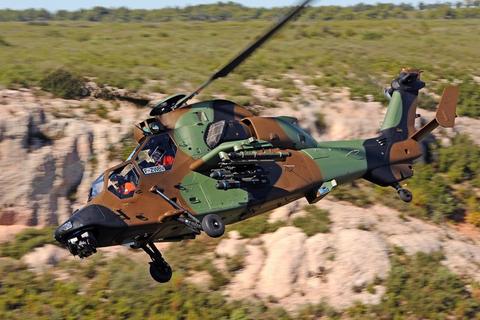
Tiger HAD France.
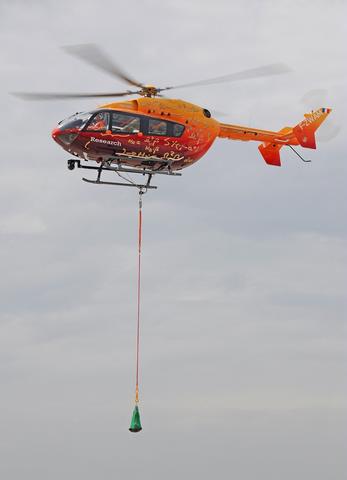
An optionally piloted vehicle (OPV) performs an unmanned demonstration flight at the French Air Force base in Istres, France.
2014
1 January: Eurocopter becomes Airbus Helicopters. The rebranding marks a new era in the history of the company as it joins Airbus and Airbus Defence & Space within the new Airbus Group.
27 January: The EC175 is certified to the latest airworthiness standards, covering both the helicopter and its new Helionix® avionics suite – which provides increased safety through reduced pilot workload, enhanced situational awareness, improved flight envelope protection and system redundancy.
Powered by Pratt & Whitney Canada’s latest PT6 engine, developed specifically for this helicopter, the EC175 has become the industry’s benchmark medium-sized twin-engine rotorcraft across a full range of missions, including transport duties in oil and gas operations, corporate and executive transport, search and rescue, emergency medical services and public services.
27 February: The new EC225e version of Airbus Helicopters’ workhorse Super Puma product line is formally launched during the Heli-Expo airshow, offering an enhanced rotorcraft.
25 March: Airbus Helicopters and China’s Avicopter sign a joint production agreement for 1,000 EC175/AC352 helicopters. While development work had been equally shared between Airbus Helicopters and Avicopter for the EC175/AC352 project, production is likewise shared, combining the capabilities of both companies. Coming from a common platform, two different rotorcraft are being built: the AC352, assembled and supported from China by Avicopter, mainly for the Chinese market; and the EC175, assembled and supported by Airbus Helicopters from Marignane, France, for the worldwide market. France and China launched their cooperation on EC175/AC352 in 2005, benefitting from 40 years of close ties between the partners on previous rotorcraft projects.
17 April: The newest member of Airbus Helicopters’ proven EC145 rotorcraft family – the EC145 T2 – is certified by EASA. Enhancements incorporated in the T2 version of the 4-metric-tonne category EC145 include new Arriel 2E engines and the company’s signature Fenestron® shrouded tail rotor, along with upgraded main and new tail rotor gearboxes, and an advanced cockpit that uses Airbus Helicopter’s innovative Helionix digital avionics suite with 4-axis autopilot
14 May: Airbus Group delivers the 300th on-time, on-budget UH-72A Lakota helicopter to the US Army. The Lakota is manufactured at the company's Airbus Helicopters, Inc. facility in Columbus, Mississipppi. Since the UH-72A contract was competitively awarded in 2006, the company has delivered the Lakota in seven different configurations for missions including training, border security, search and rescue, medical evacuation, disaster response, VIP transport and range support. Several aircraft are also in service with the US Naval Test Pilot School, which trains Navy, Marine Corps and Army test pilots.
21 May: The BO105 clocks up eight million flight hours, demonstrating the reliable service of this aircraft worldwide over 40 years. With the introduction of its hingeless main rotor head, the BO105 paved the way for the bearingless rotor systems of today’s helicopters. In total, more than 1,400 BO105 helicopters were delivered to customers between 1970 and 2009. In addition to Germany, the BO105 was also manufactured under license in the Philippines, Indonesia, Spain and Canada.
17 June: The first “built-in-Brazil” EC725 is provided to the Brazilian Navy. Brazil’s armed forces had received a total of 12 EC725s to date, with the previous 11 helicopters either supplied from Airbus Helicopters’ production site in France or partially assembled at Helibras’ Itajubá facility.
24 June: The 200th NH90, a TTH (tactical transport helicopter), is delivered by NHIndustries to Belgian Defence. The twin-engine, medium-size NH90 helicopter programme is managed by the consortium NHIndustries, owned by AgustaWestland (32%), Airbus Helicopters (62.5%), and Fokker (5.5%).
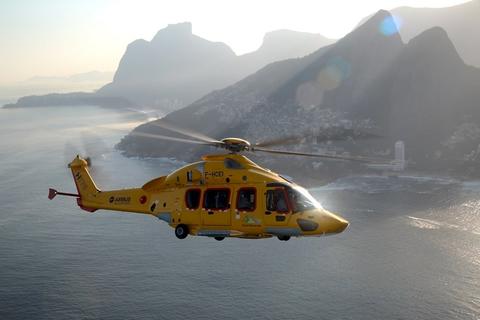
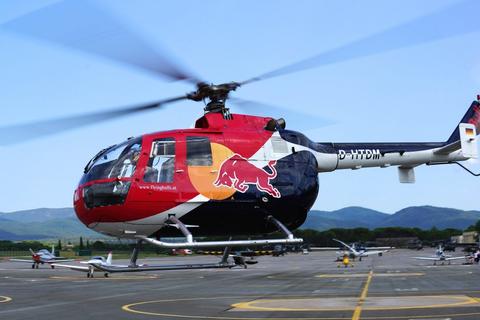
With the introduction of its hingeless main rotor head, the BO105 paved the way for the bearingless rotor systems of today’s helicopters.
21 October: EASA certifies the new EC135 T3, completing a new chapter in the EC135’s history. The EC135 T3/P3 offers more than 200 kg of additional payload in high and hot conditions. Compared to the previous version, this helicopter performs better at sea level, allowing up to 70 kg more payload for single engine/CAT performance. Notable technical improvements in the EC135 T3/P3 include a larger main rotor for more lift, and lateral air inlets for greater efficiency. The new FADEC software provides optimised engine control and the cockpit features the fully integrated navigation, communication and GPS GTN 750 avionics solution from Garmin.
27 November: The new lightweight military multi-role helicopter, the EC645 T2, completes its first flight. The EC645 T2 is the military version of the civil EC145 T2. With a maximum takeoff weight of 3.7 tonnes, the EC645 T2 can be used for a wide range of military operations including transportation, reconnaissance, search and rescue, fire support, and evacuation of wounded personnel.
2 December: Airbus Helicopters Training Services completes the instruction of its 50,000th trainee.
2015
15 January: The Airbus Helicopters fleet surpasses the 10 million flight hour milestone in service with the oil and gas sector. The milestone marks a new achievement in the 50-plus year history of heli-lift duties performed by Airbus Helicopters’ product line. Operations began with the Alouette during the 1960s and continued with rotorcraft in the Super Puma, Dauphin and Ecureuil families. The reliable BO105 and Puma contributed, as did representatives from Airbus Helicopters’ EC135, EC145, and EC120 among others. Airbus Helicopters’ new-generation EC175 is now also a part of the oil and gas global fleet, as it began operations in the North Sea following the first delivery to NHV in December 2014.
18 February: Airbus Helicopters selects the engine for the X4. The X4 programme will enter into full-scale development with a new upgraded Turbomeca Arrano engine.
19 February: Airbus Helicopters extends its research & development capabilities in Europe by opening a new design office in Łódź, Poland. This new Airbus Helicopters Polska facility will be assigned a wide variety of mechanical design activities, with a focus on future breakthrough technologies in such areas as rotorcraft drive systems and equipment. Design work in the office will cover military and commercial helicopters, new-design platforms, and modernisation of existing rotorcraft types.
3 March: The H160 is unveiled on Airbus Helicopters’ Heli-Expo booth in Orlando, Florida. Incorporating Airbus Helicopters’ expertise in aerodynamics, rotor blade design and avionics, the twin-engine H160 is an all-new medium-sized aircraft capable of a full range of civil and parapublic missions.
5 March: Airbus Helicopters announces the new “H” designations across its product lines, symbolic of the company’s full integration in the Airbus Group and consistent with the numbering used by the Airbus commercial jetliner manufacturer. The “H” is not just for its product line: Airbus Helicopters also rolls out its HCare Customer Service offer.
16 March: Airbus Helicopters is selected for the partnership development of South Korea’s light civil and light armed helicopters. Airbus Helicopters will join Korea Aerospace Industries in developing two 5-tonne class rotorcraft that meet South Korea’s requirements for its next-generation light civil helicopter (LCH) and light armed helicopter (LAH).
25 March: Airbus Group delivers to the US Army the first UH-72A Lakota helicopter to come off the Airbus Helicopters Inc. production line configured for the Lakota’s latest mission, as the service’s initial-entry training helicopter.
21 April: Airbus Helicopters and its partner Heli Invest Services welcome the decision of the Polish Ministry of Defence to pre-select the H225M Caracal from Airbus Helicopters.
15 May: Airbus Helicopters’ militarised H145M receives its on-time EASA certification.
13 June: First flight of the H160 in Marignane (France). The flight test campaign has been launched and the next flights begin to progressively open the flight envelope. The aircraft reaches 130 kts during the second flight.
16 June: Airbus Helicopters launches the X6 concept phase, setting the standard for the future in heavy-lift rotorcraft. X6 will initially target oil and gas missions and will also be perfectly suited for search and rescue, VIP and other applications.
17 June: Officially launched at the Paris Air Show, the H Pilot Club will create a dialogue among flight crews, mechanics and customers who own and operate Airbus Helicopters rotorcraft, while also providing opportunities for meetings to network within the industry, share best practices and get more insight into Airbus Helicopters.
19 June: Switzerland’s Air Zermatt receives the first Airbus Helicopters H130 configured for aerial work.
6 July: Eco-friendly and eco-efficient technologies of tomorrow take to the sky with Airbus Helicopters’ Bluecopter demonstrator. In the more than 28 flight hours logged during evaluations performed throughout its operating envelope, Bluecopter confirms the feasibility of Airbus Helicopters’ advancements in eco-friendly helicopter design while also proving the company’s next-generation eco-efficient technologies.
9 September: CM International Financial Leasing Corp., Ltd. (CMIFL) announces it intent to acquire 100 Airbus Helicopters Ecureuil-series rotorcraft over five years, with the initial order of 10 units to be delivered in 2016. CMIFL plans to offer these light single-engine helicopters to operators complete with financing solutions, paving the way for easier and faster development of China’s burgeoning general aviation sector.
19 October: The German State Police of Baden-Württemberg receive the world’s first H145 in law enforcement configuration. The aircraft is the first of an order of six to be handed over to the launch customer.
30 October: A Letter of Intent (LOI) for the establishment of a final assembly line (FAL) of Airbus Helicopters’ H135 in China is signed by Yao Yixian, the Sino-German Ecopark Deputy General Manager and Wolfgang Schoder, Airbus Helicopters Deutschland CEO in Hefei, Anhui Province. This LOI also includes a commitment by the Chinese party for 100 H135s to be assembled in the future FAL in China over the next 10 years.
6 November: Airbus Helicopters successfully completes the first flight test of the high-compression engine demonstrator aircraft at Marignane Airport. The development and flight test of this new technology demonstrator is part of the European Clean Sky initiative’s Green Rotorcraft Integrated Technology Demonstrator (ITD) programme, with support for these flight tests provided by the consortium of TEOS Powertrain Engineering and Austro Engine GmbH.
17 November: In a ceremony with Guillaume Faury, CEO of Airbus Helicopters, and in the presence of Alexandru Nastase, Romanian? Secretary of State, Airbus Helicopters places the foundation stone of its new Romanian factory, established to assemble the latest helicopter to join the H family of aircraft – the H215.
22 December: The French Defense Procurement Agency (DGA) orders seven additional Tiger HAD attack helicopters, bringing the total number to 67 Tigers that will eventually be operated by French Army Aviation. The additional Tigers will be delivered in 2017-2018.
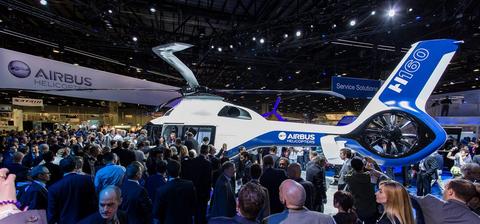
The H160 is unveiled on Airbus Helicopters’ Heli-Expo booth in Orlando, Florida.
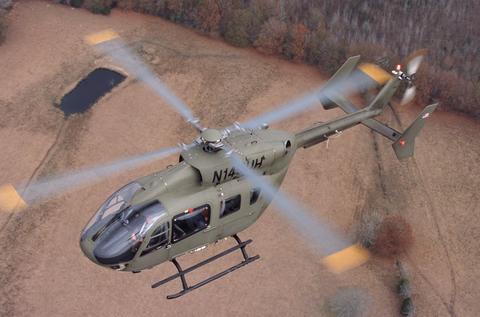
More than 400 UH-72A Lakota helicopters have been produced for the U.S. Army to meet demanding military quality requirements.
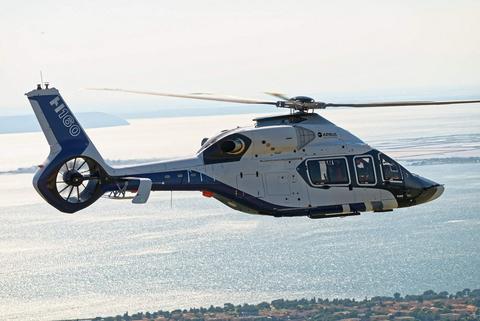
First flight of the H160 in Marignane (France).
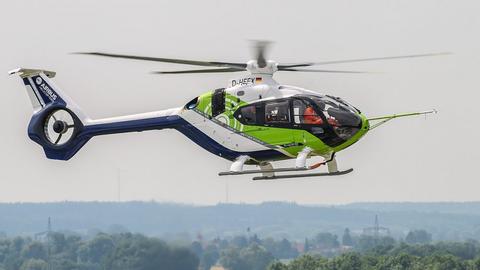
Eco-friendly and eco-efficient technologies of tomorrow take to the sky with Airbus Helicopters’ Bluecopter demonstrator.
2016
27 January: The H160’s second prototype takes off from Marignane, France, kicking off a busy 2016 for Airbus’ medium-sized helicopter as it pursues its flight test program with two prototypes.
20 May: Airbus Helicopters in the UK is selected by Ascent as the Aircraft Service Provider for the UK's Military Flying Training System (UKMFTS). The contract, worth £500 million over 17 years, will see Airbus Helicopters deliver aircraft and an integrated support solution over the course of 18 months, ready to start training in April 2018.
This will involve the manufacture of aircraft in addition to developing the support infrastructure and training initial crews and maintenance personnel.
13 June: A Chinese consortium composed of China Aviation Supplies Holding Company (CAS), Qingdao United General Aviation Industrial development Company (Qingdao United) and CITIC Offshore Helicopter Co. Ltd (COHC) orders 100 H135 light-twin helicopters, becoming China's first customer to form an industrial partnership to launch a H135 final assembly line (FAL) in Qingdao, Shandong province.
This is an important step forward, fulfilling the commitment of purchasing 100 H135s signed in a Letter of Intent (LOI) last year.
30 June: Airbus Helicopters delivers the first VIP version of the H175, the company's new medium class twin-engine helicopter, which entered service in 2014 for offshore transportation.
9 August: The Kuwait Ministry of Defense orders 30 H225M Caracal helicopters, as well as an associated support and services package.
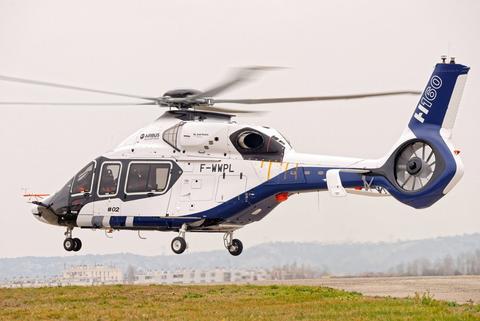
First flight of the H160 PT2.
14 September: Spanish Army takes delivery of first NH90s, with the Directorate General of Armament and Equipment (DGAM) completing transfer of the first two NH90 tactical transport helicopters from the Airbus Helicopters plant in Albacete to the Spanish Army.
28 September: The Mexican Navy receives the first of 10 AS565 MBe Panther helicopters it purchased in 2024, becoming the first customer in the world to receive the new version of this multi-role, medium-class military rotorcraft. The Navy will receive three other units before the end of the year, and the remaining six by early 2018.
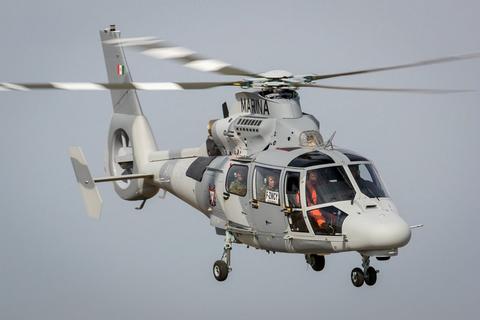
Delivery of the first AS565 MBe Panther to the Mexican Navy.
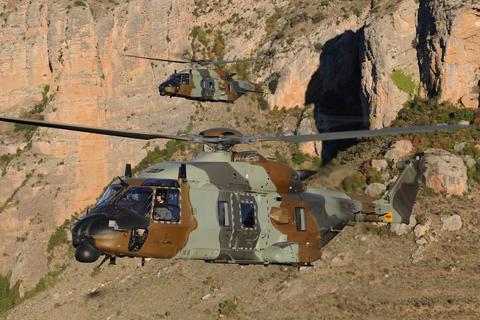
Delivery of the first two NH90 to the Spanish Army.
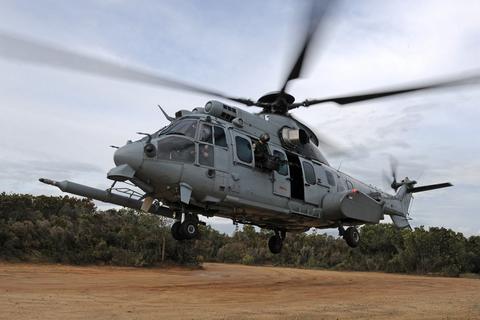
The H225M Caracal multirole utility helicopter is ordered by the Kuwait Ministry of Defence.
2017
3 March: The H160 is selected as the basis for France’s Joint Helicopter replacement programme (Helicoptères Interarmées Légers – HIL).
19 June: Airbus Helicopters begins autonomous flight trials of a VSR700 Optionally Piloted Vehicle (OPV) demonstrator, paving the way for a first flight of the actual VSR700 prototype in 2018.
31 August: The H145M performs its first flight with a complete HForce weapons system in Donauwörth, Germany. With this modular weapons system designed by Airbus, the H145M can be equipped with all types of guided and ballistic armament, including missiles, laser guided rockets, guns and machine guns.
4 September: The Norwegian air ambulance operator Norsk Luftambulanse AS (NOLAS) is the first civil customer to receive an H135 equipped with Airbus’ Helionix avionics system, which provides greater mission flexibility and operational safety.
13 October: The third H160 prototype (PT3) performed its maiden flight. With its cabin interior configuration similar to that of a serial aircraft, the PT3 prototype will contribute to the H160’s certification activities and flight testing.
24 November: The second prototype of the NH90 Sea Lion – commissioned by Germany’s Federal Office of Bundeswehr Equipment, Information Technology and In-Service Support – lifts off from the Airbus facility in Donauwörth site for its maiden flight.
19 December: The CityAirbus programme reaches another milestone: the completion and power-on for the "iron bird" ground test facility in Taufkirchen, Germany. City Airbus is multicopter vehicle demonstrator that focuses on advancing remotely piloted electric vertical take-off and landing (eVTOL) flight.
29 December: The Naval Group and Airbus Helicopters consortium is awarded a contract for technology development in the field of rotary-wing drones by the French DGA (Direction Générale de l'Armement). This contract covers de-risking studies ahead of construction of a future VSR700 programme tactical helicopter drone demonstrator for use aboard warships.
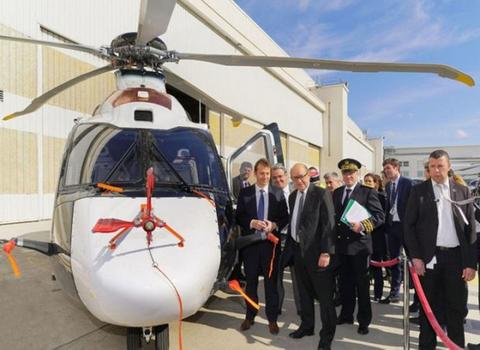
The French Defence Minister announces the choice of H160 for France’s Joint Helicopter replacement programme.
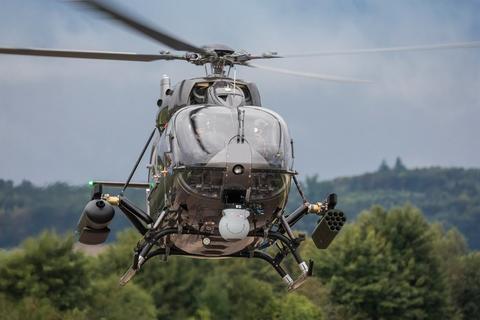
The H145M’s modular weapons HForce system was designed by Airbus.
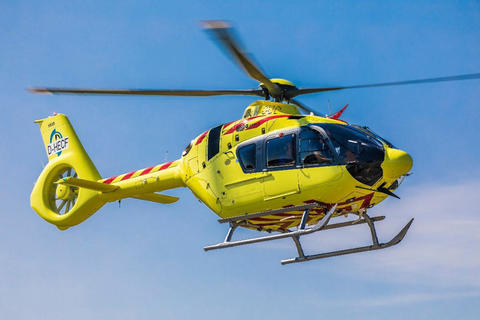
The H135 equipped with Airbus’ Helionix avionics system.
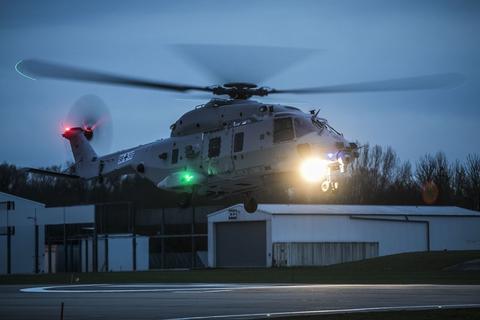
The German Navy’s second NH90 prototype lands after its successful maiden flight
